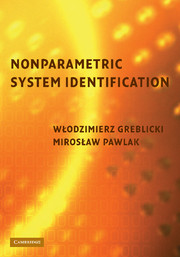Book contents
- Frontmatter
- Contents
- Dedication
- Preface
- 1 Introduction
- 2 Discrete-time Hammerstein systems
- 3 Kernel algorithms
- 4 Semirecursive kernel algorithms
- 5 Recursive kernel algorithms
- 6 Orthogonal series algorithms
- 7 Algorithms with ordered observations
- 8 Continuous-time Hammerstein systems
- 9 Discrete-time Wiener systems
- 10 Kernel and orthogonal series algorithms
- 11 Continuous-time Wiener system
- 12 Other block-oriented nonlinear systems
- 13 Multivariate nonlinear block-oriented systems
- 14 Semiparametric identification
- A Convolution and kernel functions
- B Orthogonal functions
- C Probability and statistics
- References
- Index
1 - Introduction
Published online by Cambridge University Press: 06 November 2009
- Frontmatter
- Contents
- Dedication
- Preface
- 1 Introduction
- 2 Discrete-time Hammerstein systems
- 3 Kernel algorithms
- 4 Semirecursive kernel algorithms
- 5 Recursive kernel algorithms
- 6 Orthogonal series algorithms
- 7 Algorithms with ordered observations
- 8 Continuous-time Hammerstein systems
- 9 Discrete-time Wiener systems
- 10 Kernel and orthogonal series algorithms
- 11 Continuous-time Wiener system
- 12 Other block-oriented nonlinear systems
- 13 Multivariate nonlinear block-oriented systems
- 14 Semiparametric identification
- A Convolution and kernel functions
- B Orthogonal functions
- C Probability and statistics
- References
- Index
Summary
System identification, as a particular process of statistical inference, exploits two types of information. The first is experiment; the other, called a priori, is known before making any measurements. In a wide sense, the a priori information concerns the system itself and signals entering the system. Elements of the information are, for example:
the nature of the signals, which may be random or nonrandom, white or correlated, stationary or not, their distributions can be known in full or partially (up to some parameters) or completely unknown,
general information about the system, which can be, for example, continuous or discrete in the time domain, stationary or not,
the structure of the system, which can be of the Hammerstein or Wiener type, or other,
the knowledge about subsystems, that is, about nonlinear characteristics and linear dynamics.
In other words, the a priori information is related to the theory of the phenomena taking place in the system (a real physical process) or can be interpreted as a hypothesis (if so, results of the identification should be necessarily validated) or can be abstract in nature.
This book deals with systems consisting of nonlinear memoryless and linear dynamic subsystems, for example, Hammerstein and Wiener systems and other related structures.
- Type
- Chapter
- Information
- Nonparametric System Identification , pp. 1 - 2Publisher: Cambridge University PressPrint publication year: 2008

